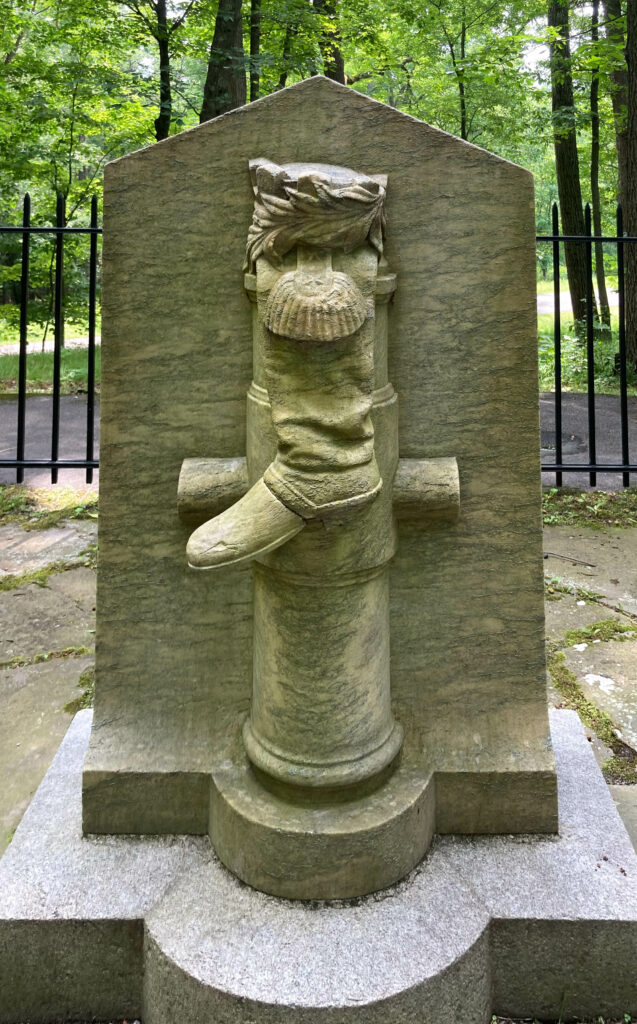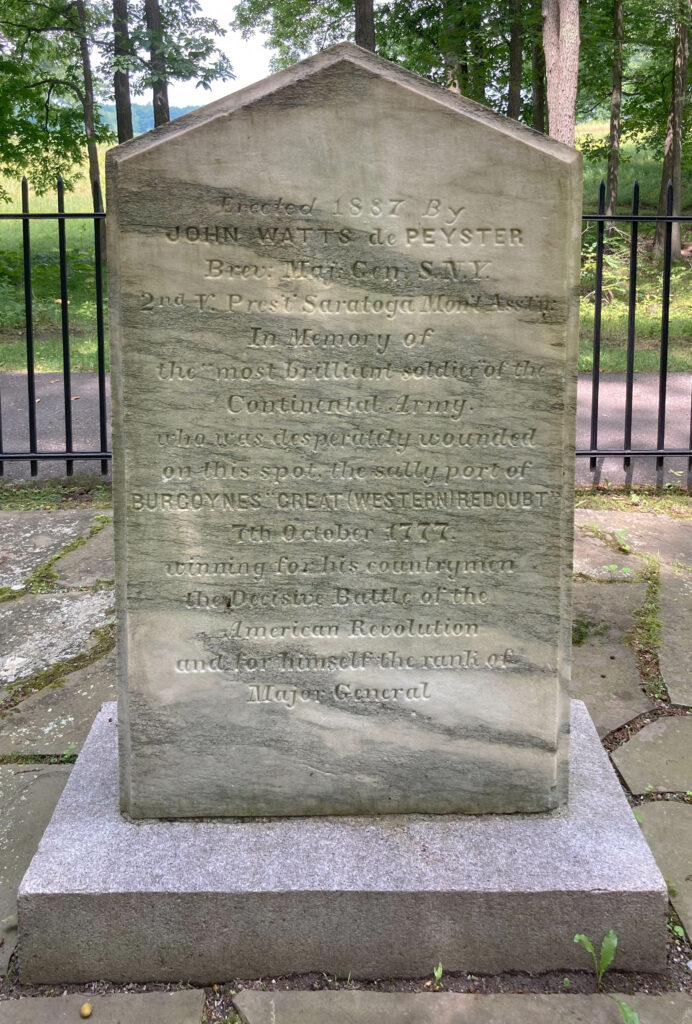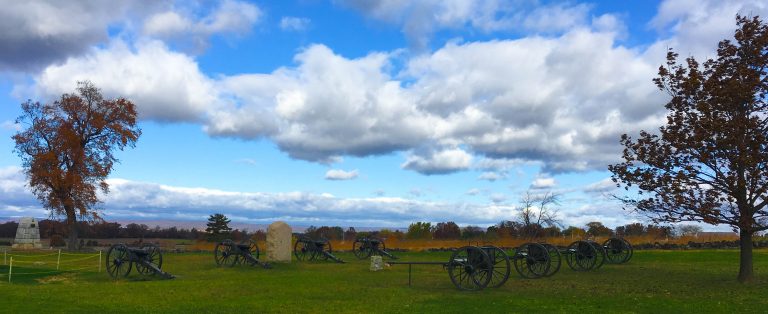Saratoga National Historical Park in New York

You don’t often see monuments to Benedict Arnold.
But Saratoga National Historical Park is one place where such a thing makes sense.
Saratoga played host to two Revolutionary War battles: the (First) Battle of Freeman’s Farm on September 19, 1777, and the Battle of Bemis Heights (also known as the Second Battle of Freeman’s Farm) on October 7.
This post contains affiliate links. For more information, click here.
Americans’ win at Saratoga was the turning point of the War, because it convinced France to come to our aid against Britain. And Benedict Arnold was key to that victory, thanks mainly to his extraordinary ability to pinpoint reverberating tactical moves, even in the chaos of battle, as well as his remarkable bravery.
But first, some background: The Hudson River is the most important river east of the Mississippi. It flows 315 miles from the Adirondack Mountains in upstate New York to the Atlantic Ocean at New York City, making it a major transportation route, especially before modern technology. It also lies within 200 miles of New England. In the early years of the Revolution, the hub of Patriot activity was New England, and especially Massachusetts, where the Boston Massacre occurred in 1770, the Boston Tea Party in 1773, and the Battles of Lexington and Concord (which began the War) in 1775.
Benedict Arnold, Hero
British Major General John Burgoyne figured that he could cut New England off from the other states by seizing control of the Hudson River.
He had taken ground in the northern Hudson River Valley and was moving his troops south toward Albany, where he believed his colleague Maj. Gen. William Howe and his troops would meet him. Unfortunately for Burgoyne, Howe chose instead to attack Philadelphia. Burgoyne crossed the Hudson anyway with 6,000 troops on September 13 and continued to Saratoga.
By this time, the American in control of the northern Continental Army was Maj. Gen. Horatio Gates. His second-in-command was Brigadier General Benedict Arnold.
According to history, the two men could not have been more different. Gates was cautious, probably to a fault; Arnold was impetuous, tragically to a fault.
Gen. Arnold commanded 2,000 of the 7,000 Continental soldiers at Saratoga, but his location was particularly crucial because it was the highest. It was also heavily wooded and ideal for hiding. Arnold convinced Gates to strengthen this area.
First Battle of Saratoga
On September 19, the British advanced toward the Americans’ position, but the Americans fired first. From Gen. Arnold’s flank, Colonel Daniel Morgan’s marksmen took out several of the British officers, leaving their foot soldiers demoralized and without full command. The fighting went on for hours before the Americans retreated.
Gen. Burgoyne could claim victory, but it was a Pyrrhic one, as the British lost nearly five times as many soldiers as the Americans, mostly thanks to men under Gen. Arnold’s command.
In the wake of this, the personality conflict between Generals Gates and Arnold came to an angry and reportedly profane shouting match between the two.
Second Battle of Saratoga
They were still arguing on October 7, when, gathered over lunch with other officers, they heard the sounds of gunfire. Arnold pestered Gates into letting him ride out to see what was up. Gates eventually relented and let Arnold go, with Maj. Gen. Benjamin Lincoln.
The two generals found the British preparing to attack the Americans. They reported this to Gates and persuaded him to strengthen his attack force.
Soon after, Arnold spotted General Simon Fraser, commander of the British right, and asked Col. Morgan to order a sharpshooter to take him out. He did, and Gen. Fraser’s fall (he would later die of his wounds) appears to have started the snowball that ended with the British in retreat.
The Americans would eventually drive the British from the battlefield, thanks in large part to Benedict Arnold.
Benedict Arnold Shot
And if he’d left it at that, Gen. Arnold’s life might have gone differently.
But later in the day, he noticed that a British defensive structure known as Breymann’s Redoubt, manned primarily by German soldiers, was vulnerable through a sally port at its rear. While Col. Morgan’s men attacked from the front and sides, Arnold burst through the sally port. The surprise attack destroyed a key British defensive position.
But a German soldier fired a musket ball into Arnold’s left thigh, killing his horse, which collapsed and pinned him to the ground.
Gen. Burgoyne surrendered on October 17. Gen. Arnold spent months recovering. It was the second time he’d been shot in the left leg; the first was nearly three years earlier at Québec. When the leg finally healed, it was two inches shorter than the right. He would eventually be able to sit a horse again and to walk with the help of a platform shoe.
Benedict Arnold, Traitor
So, what happened? Why would Benedict Arnold betray the country he’d so bravely served?
As is often the case with potentially great men, it appears that hubris was Benedict Arnold’s undoing. He was peevish, greedy, and resentful.
He also had some legitimate grievances.
First and foremost was the delay in his promotion to Major General. Foreshadowing the lunacy of modern personnel practices, the Continental Congress had decided to put a quota on the number of Major Generals from each state. And since Gen. Arnold’s native Connecticut had reached its quota, he missed out on a promotion while other men, whom he not unreasonably deemed less vital to the American cause, advanced above him. Gen. George Washington intervened, but by the time Arnold’s promotion finally came through, bitterness had already taken root in him.
Then there was money. He had sustained considerable expenses during the War, for which the Continental Congress was slow to reimburse him. (Arnold was not alone in this. The Continental Congress was terrible about paying soldiers, and when it did, its money was so inflated it was nearly worthless. Hence the expression, “Not worth a Continental”.)
And Benedict Arnold liked money, and the things, and the lifestyle, and the prestige that money can buy. He came from a once-eminent family, but his unfortunately drunken and pretentious father went bankrupt. But having tasted the dregs of prominence in his youth, it seems the touchy Arnold felt entitled to the real thing.
Valley Forge
After Saratoga, though he still wasn’t able to fight, the newly minted Maj. Gen. Arnold arrived at Valley Forge, where he took an oath of allegiance to the United States on May 30, 1778.
While there, he was approached by James Seagrove, part-owner of a Philadelphia schooner named the Charming Nancy. The British were preparing to evacuate Philadelphia, and merchants worried that their goods would be confiscated by the Continental Army. Seagrove wanted a pass, issued by a Continental officer, that would protect the Charming Nancy‘s valuable cargo from seizure. On June 4, Arnold issued the pass, apparently in exchange for a share in the schooner.
Philadelphia
Two weeks later, Gen. Washington appointed Gen. Arnold military governor of Philadelphia. It was a position that would allow him many more opportunities for such financial shenanigans. But even so, he also assumed significant debt.
The post also allowed him to meet and eventually marry Peggy Shippen. Nearly 20 years his junior, she was the daughter of a well-off royalist family acquainted with British intelligence officer Major John André.
As time went on, Arnold’s shady dealings drew the attention of Joseph Reed, a former delegate to the Continental Congress and then-president of Pennsylvania‘s Supreme Executive Council, basically the equivalent of a state’s Governor. Reed launched an investigation of Arnold that led to the latter’s being court-martialed on charges that boiled down to abusing his influence in exchange for financial gain.
Perhaps the fact that these charges were almost certainly true added to Arnold’s resentment. He wrote Washington a letter complaining, “Having made every sacrifice of fortune and blood, and become a cripple in the service of my country, I little expected to meet the ungrateful returns I have received of my countrymen, but as Congress have stamped ingratitude as a current coin I must take it.” He was acquitted on January 26, 1780, of all charges except issuing the Charming Nancy pass, for which he was issued a formal reprimand by Washington.
By this time, the resentful Arnold had already offered his espionage services to the British. He was communicating via coded message with Maj. André, with correspondence often passed through his wife Peggy, feeding the British information like American troop and supply locations, and arguing over the compensation he wanted for his betrayal.
West Point
At some point, Gen. Arnold either hatched or accepted a plan to surrender West Point to the British for £20,000.
Gen. Washington considered the Point, a site hosting three forts at an S-shaped curve in the Hudson River, to be America’s most important strategic position of the Revolutionary War.
Washington appointed Arnold its commander on August 3, 1780. Arnold shortly began weakening its defenses. He met there with Maj. André to discuss the details of the plan on September 21.
As André headed back to British-held territory on September 23, American militiamen captured him. They searched him and found the plans for the West Point surrender in his stocking. Arnold learned of André’s fate and fled to the British side.
Maj. André was court-martialed and sentenced to death. Pointing out that he was an officer and not a spy, he appealed to Gen. Washington and asked to be shot rather than hanged.
Washington insisted that André be hanged as an example. Some think that this was at least partially in retaliation because the British had four years earlier hanged 21-year-old American spy Nathan Hale.
Over the objections of Washington’s officers including Alexander Hamilton and the Marquis de Lafayette, André was hanged on October 2. (My great-great-great-great-great-great-great-grandfather Brig. Gen. John Glover was the officer of the day.)
Benedict Arnold, Redcoat
Ironically, Benedict Arnold soon became a Brigadier General in the British army. He received £6,000 for his treachery. He spent the next three years of the War attacking Americans.
After the War, he moved to London, then to Canada, then back to London, making enemies along the way with shady dealings. He died on June 14, 1801, at the age of 60.
Greed and grudge-holding are two things people believe can protect themselves and their pride from the vicissitudes of life, but these flaws are ultimately, tragically, ironically corrosive to those who cling to them.
The Boot Monument at Saratoga National Historic Park lauds
the ‘most brilliant soldier’ of the
Continental Army
who was desperately wounded
on this spot, the sally port of
BURGOYNE’S ‘GREAT (WESTERN) REDOUBT’
7th October 1777
winning for his countrymen
the Decisive Battle of the
American Revolution
and for himself the rank of
Major General
But it doesn’t mention his name.
* * *
What to Know before You Go to
Saratoga National Historical Park
The Saratoga National Historical Park Visitor Center is located at 648 Route 32 in Stillwater, New York. There you can view a 20-minute orientation film, see museum displays, and pick up maps.
Then you may take a 10-stop, self-driving tour of the Park. Interesting sites include the house where Gen. Fraser died and his burial site; the location of Gen. Burgoyne’s October retreat, with a view of the Hudson River, and Breymann’s Redoubt, with the nearby Boot Monument, which commemorates Benedict Arnold’s leg wound. Allow one to three hours.
For more information about Benedict Arnold, I recommend Nathaniel Philbrick’s Valient Ambition: George Washington, Benedict Arnold, and the Fate of the American Revolution.
To book a room at the Stash-affiliated Saratoga Casino Hotel, click here.
Planning travel to New York? You might be interested in:
- National Baseball Hall of Fame and Museum in Cooperstown
- Old Fort Niagara in Youngstown
- Where to Stay in upstate New York

After my misspent youth as a wage worker, I’m having so much more fun as a blogger, helping other discerning travellers plan fun and fascinating journeys. Read more …











I was there years ago. I wish I had more time to see the battlefield.
Thanks, John, it’s well worth exploring.